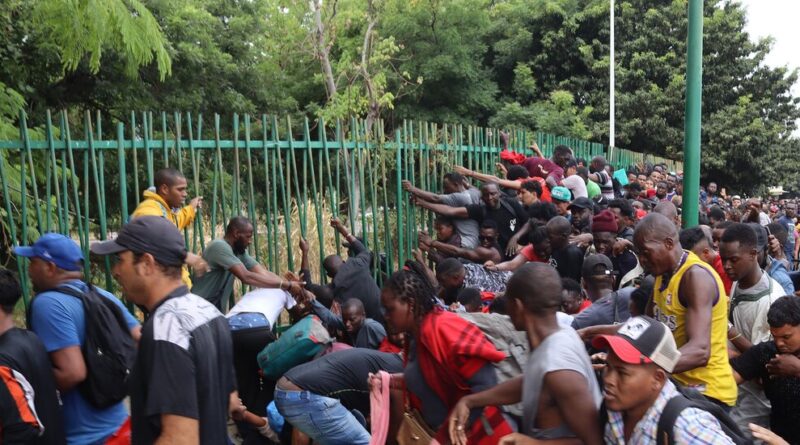Mexico Allows Tens of Thousands of Migrants to Travel to U.S. Border
[ad_1]
Mexico has let tens of thousands of people cross its territory on their way to the American border since early April, government data shows, a major uptick before the expiration of a U.S. immigration measure that has kept most migrants from being able to claim asylum in the United States.
The increase comes as local aid groups and migrants say that over the last several weeks people heading north have been crossing more easily into Mexico from Guatemala, the main route to the United States, with Mexican security forces abandoning some of their outposts on the country’s southern border.
The jump in people allowed to cross Mexico, coupled with the reduced security footprint, has likely contributed to the soaring numbers of migrants gathered at the U.S.-Mexico border as the Biden administration prepares on Thursday night to lift a pandemic-era restriction called Title 42 that has allowed the United States to quickly expel those trying to cross the border illegally.
Mexico’s Foreign Ministry and National Institute of Migration did not respond for requests for comment about any changes to the government’s immigration policy.
Local aid workers, however, said that the public-health measure’s expiration was likely feeding a rise in migrants arriving at Mexico’s southern border.
“We do not know if this is solely related to Title 42, but it is evident there are many more migrants here than normal,” said Miguel Barrera, a field coordinator at the International Rescue Committee in Tapachula, a city near Mexico’s southern border.
From April 2 to May 3, nearly 30,000 humanitarian visas were issued to migrants in Chiapas state, which shares a border with Guatemala, according to figures released by Mexico’s National Institute of Migration, more than triple the monthly average in the first three months of the year.
The visas allow migrants to travel within the country, buy bus tickets and airfare, and make their way to the United States border.
The Mexican government has long issued thousands of such documents to migrants, particularly those coming from countries like Haiti and Venezuela experiencing humanitarian crises.
But visa numbers increased sharply in the last month as authorities issued them to anyone who asked, according to local humanitarian groups. Instead of detaining migrants without proper documents, as had been the usual practice, migration authorities directed them to a park on the edge of Tapachula to start the visa process.
On Wednesday, Raul Ortiz, chief of the U.S. Border Patrol, said he didn’t believe that the increase in visas being issued was contributing to the build up at the border.
In stark contrast to normal operations, migration authorities in southern Mexico have also eased militarized migration enforcement over the last month. Some highway checkpoints have been temporarily lifted and regular migration sweeps in Tapachula have ceased, according to local aid groups.
Since 2018, when then-President Donald J. Trump threatened to impose tariffs against Mexican imports if the country didn’t crack down on migration, Mexico has worked in lock step with U.S. authorities on deterrence, mobilizing as many as 28,000 National Guard troops to detain migrants.
In 2022, Mexican authorities detained more than 444,000 migrants, an all-time high.
Nowhere is this work more visible than in Tapachula. Migration checkpoints usually dot every highway leading out of the city to try to stop people without proper travel documentation. The Siglo XXI migrant detention center, the country’s largest and one regularly denounced by humanitarian groups for human rights abuses, is often at double its capacity of 960.
But on Monday morning, the facility was empty, a police officer at the entrance told The New York Times.
At a vast, tropical park on the outskirts of Tapachula, thousands of migrants waited for visa processing to restart after a weekend hiatus. They jostled in line as the morning sun pushed the temperature above 90 degrees. Local vendors sold water, shaved ice and SIM cellphone cards to migrants who could afford it.
Most of the migrants were from Central America, Venezuela, Ecuador and Haiti, but others had traveled across the globe, from countries like China and Angola. Many had come with their entire families, including young children and babies.
“I saw two news stories online saying to come here for visas,” said Moroni Padilla, 42, from El Salvador. “Sometimes you don’t know if you can trust what you hear, but I had to come see for myself.”
A migration official who was not authorized to speak on the record told The Times that his agency was not detaining migrants in the region and was instead directing them to the park to get a visa. He would not say why or who had given the new guidance.
Migration officials declined to comment on any change of enforcement strategy in the region.
In Ciudad Hidalgo, 20 miles south of Tapachula on the Suchiate River marking the border with Guatemala, Mexican government patrols had ceased almost entirely in the last month, according to local vendors ferrying goods and migrants across the river. A handful of migration agents sat at a table in the shade playing cards.
Humanitarian groups in Chiapas say the change happened gradually after a March 27 fire at a detention center in Ciudad Juárez killed 39 men trapped inside their cells. Several high-level officials from the National Institute of Migration, including the agency’s head, Francisco Garduño Yáñez, have been charged with crimes related to the fatal blaze. Officials have made no official statements about policy changes following the fire.
“Not just now but historically it has been difficult to understand the strategy or motivations behind their actions,” said Mr. Barrera, of the International Rescue Committee.
Aid groups say they are striving to provide basic care to a ballooning number of migrants. Temperatures can exceed 100 degrees in southern Mexico, which can lead to dehydration and heat stroke.
Hundreds of people were left outside in torrential rains Monday night without shelter, fearing they would lose their place in line for a visa if they left.
For most people trying to reach the United States, the elements weren’t a deterrent when they had a rare opportunity to freely travel through Mexico.
“God willing, we can make our way to the United States in the next few days,” said Freiver Parra, 27, from Venezuela, minutes after receiving his visa.
He was traveling with his wife, Kariana, 24, and his 6-year-old daughter, Ehilys. He knew Title 42 was ending but was unclear on what that meant. And he had lost track of all the rumors about U.S. immigration policy floating along the migrant route.
“You can’t trust what people tell you,” he said. “I have to see what is happening with my own eyes, and then we’ll decide what to do.”
Eileen Sullivan contributed reporting from El Paso.
[ad_2]
Source link



